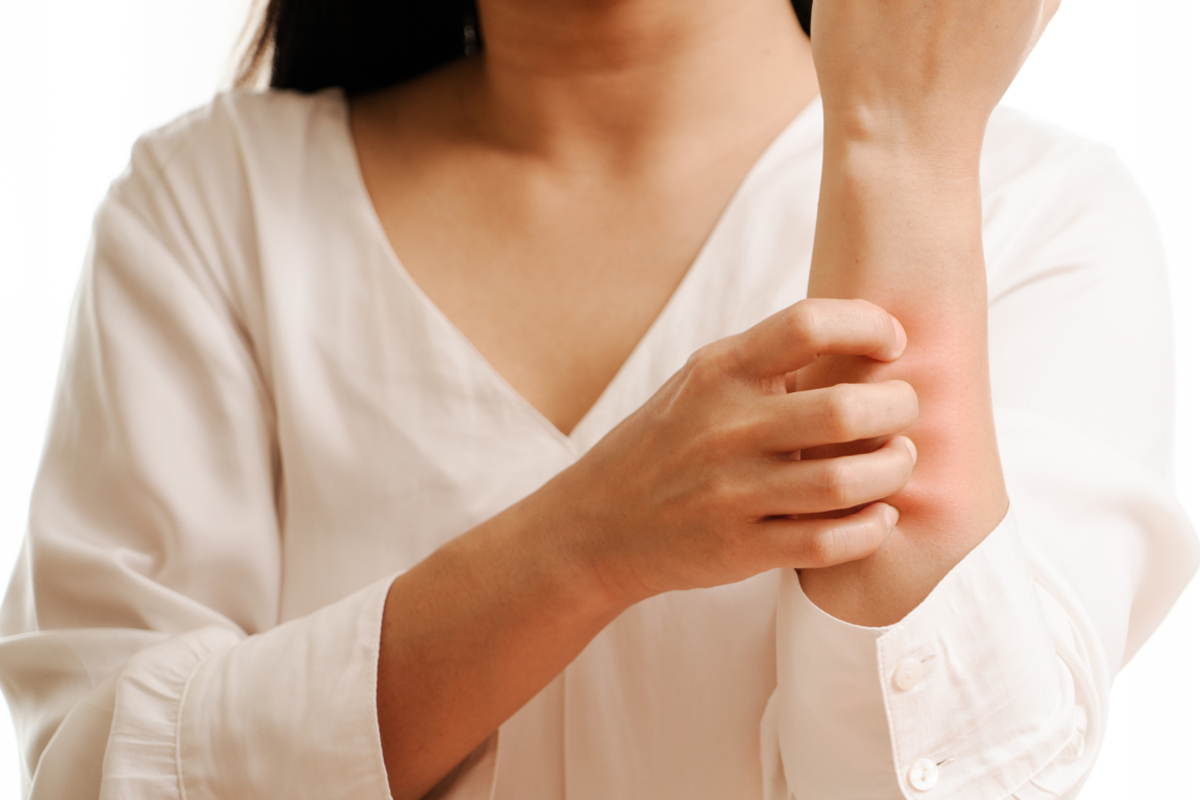Uncontrolled diabetes is associated with a rather wide range of complications, some of which affect the skin — the largest organ in the body. In fact, studies have shown that skin conditions can be the first sign that a person may have untreated diabetes. Skin conditions are very common in diabetics, and a significant percentage of people living with diabetes will, at one point or another, have a skin disorder that is caused by their diabetes.

1. Acanthosis nigricans
Acanthosis nigricans is a disease in which the skin becomes dark (often tan or brown), thick, and slightly raised. Generally, acanthosis nigricans affects areas such as the side of the neck, armpits, or the genital regions. It can also develop on the hands, elbows, and knees. While acanthosis nigricans can occur in healthy people, people with diabetes have a higher risk of developing the disease.
2. Allergic reactions
Patients with diabetes have a higher likelihood of developing an allergic reaction, particularly in regions where they inject their insulin. Thus, it is important to look out for rashes and bumps in that region of the skin and seek help from a doctor if you find evidence of an allergic reaction.
3. Atherosclerosis
Diabetes is characterized by high blood sugar levels, which damages blood vessels and can lead to the development of cardiovascular complications. Atherosclerosis is a condition in which the blood vessels that supply oxygen and nutrients to the cells start to narrow. This causes the cells (including skin cells) to have a lack of oxygen, leading to thinning and shiny skin, as well as skin that feels cold to the touch.
4. Bacterial infections
Patients with diabetes have an impaired immune system because high blood sugar levels can have damaging effects on immune cells. Therefore, diabetics have a higher risk of developing bacterial infections of the skin. This is particularly true because patients with diabetes are slow to heal when they have a skin wound or sore. The delay in healing leaves the skin exposed to bacteria, causing hot, swollen, red and painful skin.
5. Bullosis diabeticorum
Bullosis diabeticorum, also known as diabetic blisters, can develop in rare instances. These blisters look similar to burn blisters and can occur anywhere along the skin including the fingers, toes, hands, legs and arms. Generally, they are painless and heal on their own. Patients with diabetic neuropathy (a condition in which patients have damage to nerves due to high blood glucose levels) are more likely to develop diabetic blisters.
6. Diabetic dermopathy
As mentioned above, high blood sugar levels can cause damage to the blood vessels of your body, causing a lack of oxygen and nutrient delivery to the skin cells. This can cause dermopathy, in which patients develop patches of scaly skin that are light brown, red and located on the front of the legs. These patches are painful or blistery and don’t itch.
7. Digital sclerosis
Digital sclerosis refers to a condition in which the skin of the toes, fingers and hands hardens and becomes thick and tight. This condition is more likely to occur in patients with diabetes.
8. Eruptive xanthomatosis
Eruptive xanthomatosis is a condition that occurs in diabetic patients whose blood glucose levels are not well controlled and who have high lipid levels as well. This causes the development of hard, yellow and pea-sized bumps on the skin which are generally surrounded by red halos. These can be itchy and found in various regions of the body including the arms, legs, buttocks and back. Eruptive xanthomatosis can be treated with drugs that lower fat levels in the blood.
9. Fungal infections
It is well-known that people with diabetes are more likely to develop fungal infections. Essentially, a yeast-like fungus causes itchy red rashes, small blisters, and scales. These occur in warm and moist areas of the skin. Treatment of these fungal infections infections includes keeping the region dry and using anti-fungal medication.
10. Itching
Itching can strike diabetes patients for various reasons, such as yeast infections, dry skin, or reduced blood flow (due to damage to blood vessels). This is can affect different regions of the skin, including the lower legs and feet.
11. Necrobiosis lipoidica diabeticorum
Necrobiosis lipoidica diabeticorum is a disease in which the skin takes on a raised, yellow and waxy appearance. Over time, Necrobiosis lipoidica diabeticorum becomes itchy and can cause pain. However, unless the sores break open, you don’t need to treat them and they will go away by themselves.
12. Scleroderma diabeticorum
Scleroderma diabeticorum is a condition in which the skin of the back thickens. This appears to mostly affect overweight people with diabetes.
- Spravchikov, Natalia, et al. "Glucose effects on skin keratinocytes: implications for diabetes skin complications." Diabetes 50.7 (2001): 1627-1635.
- Romano, G., et al. "Skin lesions in diabetes mellitus: prevalence and clinical correlations." Diabetes research and clinical practice 39.2 (1998): 101-106.
- Behm, B., et al. "Skin signs in diabetes mellitus." Journal of the European Academy of Dermatology and Venereology 26.10 (2012): 1203-1211.
- Photo courtesy of SteadyHealth


Your thoughts on this